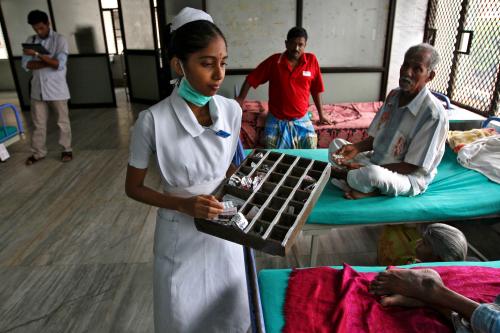Content from the Brookings Institution India Center is now archived. After seven years of an impactful partnership, as of September 11, 2020, Brookings India is now the Centre for Social and Economic Progress, an independent public policy institution based in India.
The COVID-19 pandemic has sent shockwaves throughout the global economy. Some economies have been affected more severely than others. It started with a few deaths in Wuhan, China, with the earliest reported case on November 17, 2019. By December 31, 2019, when the Chinese authorities first reported it to the World Health Organization (WHO), it was already a full-fledged outbreak. From the outbreak in Wuhan, the virus took different times to reach the borders of different countries, depending on various factors such as connectivity and proximity to the Chinese city. Within different countries, the virus spread through the population at varying speeds depending on a range of factors such as cultural and behavioural responses of the community, population density, average household size, among others. This pattern has led to substantial variation in the preparedness of countries and their responses to the crisis. In this article, we trace the timeline of the spread of COVID-19 in the early days [i] to different countries and their proactiveness in implementing some common social distancing measures.
When tackling a virulent virus like COVID-19, early interventions are crucial to stay ahead of the disease and we restrict our analysis to the first few hundred cases. We use COVID-19 data from Johns Hopkins CSSE repository [ii] and data on a few commonly used government interventions from the Oxford COVID-19 government response tracker [iii]. It is important to note that we use the earliest date for the strictest interventions and not advisories or cautionary notes sent by the governments since advisories can easily be ignored by the citizens.

Japan, South Korea and the United States confirmed their first case of COVID-19 approximately three weeks after the reported outbreak in China. From then on, disease progression within these countries varied quite a bit. While it took 42 days to reach 100 confirmed cases in the U.S., Japan reached that number in 31 days and South Korea in 29 days. Subsequently, the rate of progression increased drastically in South Korea and the U.S., and relatively less rapidly in Japan. Japan’s early success can partly be attributed to early social distancing measures like closure of schools until April and targeted testing of clusters [iv]. South Korea first cancelled all public events, then imposed an international travel ban even before the 100th case was reported. South Korea embarked on developing their own test and adopting a policy of stringent testing following by contact tracing [v]. As of March 29, the U.S. has over 140,000 confirmed cases while South Korea has over 9,000 confirmed cases and Japan has over 1,800 confirmed cases.
Singapore and France both reported their first confirmed case 23 and 24 days from the outbreak and both countries reached 100 confirmed cases in 37 and 36 days, respectively. Singapore promptly instituted an international travel ban around the same time as their first confirmed case, followed by a very strict screening and quarantine measures [vi]. France, in contrast, instituted only screening measures for international travellers a few days later and a ban on public events around the same time that its confirmed cases rose to 100. Other social distancing measures were instituted much later. The number of confirmed cases in Singapore rose more slowly than France, with Singapore reporting 844 confirmed cases and France reporting over 40,000 confirmed cases as of March 29.
India reported the first confirmed case 29 days after the outbreak around a month after the report of the outbreak around the same time as Italy, the U.K., Spain and Belgium. Italy was more proactive than India in instituting international travel controls. Yet, Italy confirmed 100 cases in another 23 days compared to India’s 45 days. India started taking social distancing measures like closing workplaces and schools before reaching 100 confirmed cases. But public gatherings were still occurring in Italy, the most crucial of which turned out to be a football match [vii]. As of March 29, India had over 1,000 confirmed cases while Italy had over 97,000 confirmed cases. The U.K., Spain, Belgium also confirmed their first cases around the same time as India and Italy but have not been as proactive about policies. The result of their delay can be seen in the number of their confirmed cases now. As of March 29, the U.K. had over 19,000 confirmed cases, Spain had over 80,000 confirmed cases and Belgium had over 10000 confirmed cases.
Iran presents a cautionary tale, with its first confirmed case around 50 days since the report of the outbreak. It took only seven days to reach 100 confirmed cases, the shortest time taken by any country. A combination of political factors, one of which was the country’s parliamentary election (on February 21), led to Iran delaying the cancellation of public events [viii] . The social distancing measures turned out to be too late as the virus spread rapidly through the population infecting another 100 people in one day and so on. As of March 29, Iran has over 38,000 confirmed cases with a death toll of over 2000. Austria, Netherlands and Switzerland all confirmed their first case 56 days from the outbreak. All three countries have taken social distancing measures but only after the number of cases rose significantly. Austria currently has over 8,000 confirmed cases while Switzerland and Netherlands have over 10,000 confirmed cases.
As we look back at the early days of the spread of the pandemic, countries that were proactive in taking strict steps prohibiting social gathering, such as Singapore and South Korea, managed to bring the pandemic under control swiftly. The lessons learned from these severely affected nations will prove to be particularly useful for African nations where the number of cases of COVID-19 are starting to rise. These countries should immediately take stringent measures relating to international travel and social distancing.
Notes
[i] We focus our analysis on the early days of the pandemic leading up to 600 confirmed cases or more because we want to look at the proactive of government responses.
[ii] https://coronavirus.jhu.edu/map.html
[iii]https://www.bsg.ox.ac.uk/research/research-projects/oxford-covid-19-government-response-tracker
[iv] https://www.bbc.com/news/world-asia-51663182
[v] https://www.wired.co.uk/article/south-korea-coronavirus
[vi] https://theconversation.com/why-singapores-coronavirus-response-worked-and-what-we-can-all-learn-134024
[vii]https://timesofindia.indiatimes.com/sports/football/top-stories/game-zero-spread-of-virus-linked-to-champions-league-match/articleshow/74817915.cms
[viii] https://foreignpolicy.com/2020/03/24/how-iran-botched-coronavirus-pandemic-response/





Commentary
The early days of a global pandemic: A timeline of COVID-19 spread and government interventions
April 2, 2020